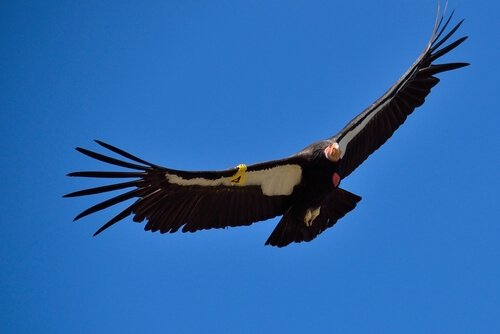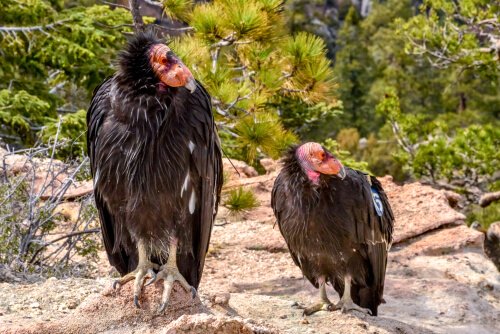California Condor: his role as a nature cleaning team
The California condor is the largest land bird in North America and once dominated the western skies. Unfortunately, the species declined for much of the 20th century until only drastic measures saved it from extinction.
California's condor population reached only 22 individuals in the world at the end of the 70s . The last group of free flight condors was taken to captivity in 1987 to save the species. Efforts to reintroduce condors began in 1992 and continue to the present.
Morphology and habitat of the California condor
The individuals of this great American vulture usually measure between 46 and 55 inches in length from head to tail. While there is some sexual dimorphism, the size difference is minimal, and the male is larger than the female.
The extension of the wings of an adult of this species can reach close to three meters . They are black with white spots and a bald head with very few feathers. The color of the head varies from white to orange and reddish purple.
The bare head of the California condor is an adaptation for hygiene , as they eat dead and rotten meat. Most of the time they must put their heads inside the corpses to feed themselves.

Condors live in rocky and forested regions that include canyons and mountains. Can be found in the deserts of southern central California . Permanent resting sites must have rocky cliffs and debris to nest.
Eating habits
The California condor has a diet that is unpalatable to humans, but vital to the ecosystem natural. These animals are part of the nature cleaning team . They play a vital role in the safe disposal of dead animals.
A healthy population of such carrion eaters can have a major impact on the disposal of sick or decomposed animals. Condors eat carrion and prefer the carcasses of large animals such as deer, cattle and sheep.
However, they also feed on animals such as rabbits and squirrels. Condors prefer fresh carcasses , but they also eat animals with high levels of decomposition when necessary.
Condors can fly about 20 kilometers a day in search of food. They find their food thanks to their visual acuity. Adult individuals require up to one and a half kilograms of meat per day, although some can consume up to three kilos a day.
Conservation status Conservation status h2>
The California condor is in danger of extinction . After several years of a successful captive breeding program in Los Angeles and San Diego, some individuals have been reintroduced since the 1990s.

Since then, more than 120 individuals have been reintroduced into the wild , but the mortality rate is high. The wild socialization of birds raised in captivity has been difficult. It has continued with the preservation of the species in captivity with a long-term plan of continuous reproduction.
The exact causes of the rapid decline of California condors in the last decade are uncertain
strong>.Also, the lead poisoning of bullets in animals killed by ranchers.Reproduction habits
The average life of the California condor is around 37 years in captivity and 45 in the wild . However, the reproductive stage begins at six years of age in the youngest. Upon reaching full maturity, the males make a courtship with the wings spread and movements of the head.
After the female accepts the proposal of the male, form monogamous couples for life . They lay a single egg every two years and the incubation period is approximately 56 days. The eggs hatch between February and April.
The nests are found in caves next to the cliff or between rocky outcrops and crevices. Both parents take care of the egg until the birth of the baby and it stays with them for a year and then leaves the nest.


